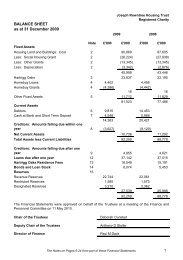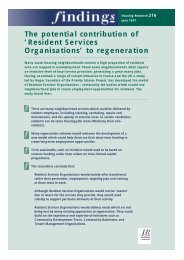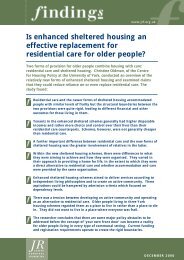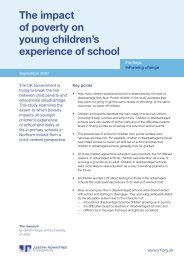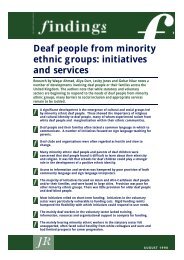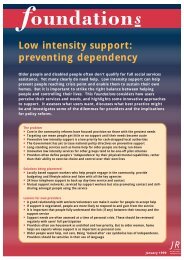Community participation - Joseph Rowntree Foundation
Community participation - Joseph Rowntree Foundation
Community participation - Joseph Rowntree Foundation
You also want an ePaper? Increase the reach of your titles
YUMPU automatically turns print PDFs into web optimized ePapers that Google loves.
4 Network dynamics: explaining the<br />
pattern<br />
I read somewhere that everybody on this planet is separated by only six<br />
other people. Six degrees of separation between us and everyone else<br />
on this planet.<br />
(Six Degrees of Separation, John Guare) 1<br />
The last chapter confirmed what Chapter 2 inferred: community <strong>participation</strong> policies<br />
designed to open up decision making carry the potential to wall it off, making it the<br />
preserve of a small group of insiders.<br />
This ‘usual suspects’ phenomenon is a familiar problem. But surprisingly little<br />
attention has been paid in policy circles to understanding it. It has usually been<br />
attributed to the behaviour of particular individuals or institutions – the failure of the<br />
usual suspects to recognise that exercising community leadership does not mean<br />
sitting on every committee; the failure of particular decision makers to look beyond<br />
the usual suspects and reach out to new constituencies; the failure of people in<br />
those constituencies to stand up and be counted. For instance, guidance about<br />
community <strong>participation</strong> usually suggests that this is simply a question of good<br />
practice and that the problems can be overcome if the institution in question tries<br />
hard enough. 2<br />
This chapter takes a different starting point. It asks whether the explanation for the<br />
emergence of a small group of insiders lies not in the behaviour of particular<br />
individuals or institutions but in the properties of local governance systems as a<br />
whole.<br />
Specifically, if we understand community <strong>participation</strong> arrangements as interactions<br />
among social networks (as a social capital perspective encourages us to do), are<br />
there features of the way these networks tend to operate that provide a more<br />
plausible explanation for the outcomes they produce than simply pinning<br />
responsibility on one particular actor within the network?<br />
We contend that there are. By marshalling evidence from our fieldwork and returning<br />
where necessary to the academic literature, we identify a number of ‘network<br />
dynamics’ that appear to have an important effect. Individually none can explain why<br />
community <strong>participation</strong> arrangements tend to run into the usual suspects problem,<br />
but their cumulative impact serves to make it highly likely.<br />
35




